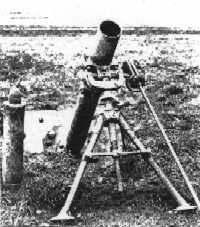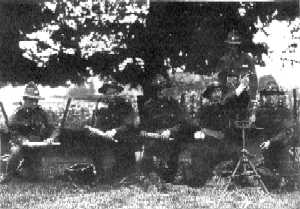|
Mr FWC Stokes (later Sir Wilfred Stokes) had had an inspiration. He had seen an alarm system in which a metal holder sliding on a vertical rod held a blank cartridge a couple of feet a bove a fixed firing pin. When a tripwire released the holder it dropped, thus firing the blank.
For the rod, Stokes simply substituted a barrel; for the blank he substituted a bomb containing a shotgun cartridge in its 'tail unit'. When the bomb was dropped tail-first down the barrel the cartridge struck the firing pin and exploded, sending the bomb on its way. Thus the ancestor of all 20th century mortars was born.
Stokes produced his prototype early in 1915. It was simple in design, easy and cheap to manufacture, but was not immediately accepted, being attacked by conservative diehards as 'an outrageous novelty' etc. Nevertheless reason eventually prevailed and it was in production by June the same year.
The bomb is not stabilised. Stokes at first proposed a fin-stabilised projectile but the authorities rejected it as too difficult to manufacture! However, it worked. Despite turning end-over-end in flight the bomb proved reasonably accurate over the short ranges for which it was designed, and continued in use until 1918. To overcome the lack of stabilisation the bomb was at first fuzed with a simple time fuze but later an 'Allways' impact fuze was developed.
The mortar was laid for elevation by clinometer. To lay for line the layer stood immediately behind the breech piece. Then by means of a white line on top of the barrel he aligned it by eye on the target or aiming point. To traverse the mortar he adjusted the supporting rods and/or shifted the breech picec into one of the recesses in the base plate.
By the end of World War 1 a bipod incorporating elevating and traversing gears had been adopted, as shown in Figure 12a.
The bipod which superseded the supporting rods etc.
The mortar illustrated is an American copy of the Stokes 3-inch in 4-inch calibre (102-mm) made in 1918.
Note that the bomb is still of the unstabilised variety. A streamlined bomb developed after World War 1 is shown in Figure 12b below. |

Figure 12a
|

Figure 12b
|
The streamlined fin-stabilised bomb developed after World War 1.
The body is of cast iron hence the filling of amatol, an explosive of comparatively low strength.
For the shorter ranges the cartridge in the tail unit sufficed; for the longer, augmenting charges were added as required. |
Figure 12c shows the Stokes mortar after World War 1. The bipod is very similar to that shown in Figure 12a. Although it is fitted with elevating and traversing gears there are no sights. The method of laying remained as described above until the Stokes was superseded by 'Ordnance ML 3-inch mortar' in 1936. The old Stokes remained in use in New Zealand until after World War 2.
The Stokes mortar after WW1
A mortar detachment of 6 Hauraki Regiment during annual camp at Rotorua in 1936. Note the original unstabilised bombs. |

Figure 12c
|
Return to top
previous |
index |
next
History index |
Home |
Wally Ruffell
|